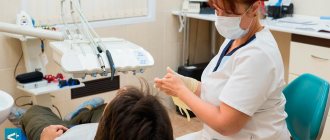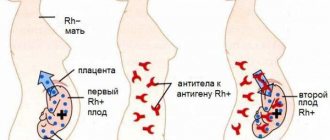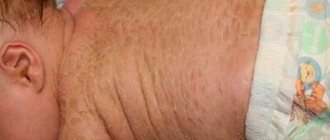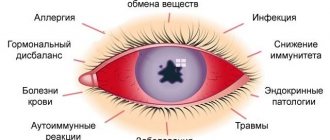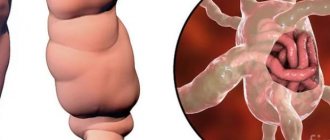General information
The term jaundice or icteric syndrome refers to icteric discoloration of the skin and mucous membranes.
This is an external manifestation of an increased content of bilirubin (bile pigment), which permeates the tissue (the term imbibition is used). This symptom occurs in many diseases in adults and newborns. Neonatal jaundice of newborns can be physiological and pathological (occurs in 1% of cases). Neonatal jaundice has an ICD-10 code from P58 to P58.9, including subcategories that explain its causes. The important thing is that icteric syndrome can be a manifestation of pathological conditions. The pediatrician’s task when jaundice is detected is to analyze the causes, other symptoms and laboratory indicators to choose the correct treatment tactics.
Physiological jaundice of newborns (sometimes the term postpartum jaundice is used) is considered a borderline, transient condition and occurs quite often. According to various sources, it occurs in 30-50% of full-term infants and in 70-85% of premature infants. The appearance of jaundice in newborns is associated with impaired bilirubin metabolism due to enzymatic immaturity of the liver. Bilirubin is a breakdown product of hemoglobin; in this case, after the birth of a child, fetal red blood cell hemoglobin undergoes breakdown and adult hemoglobin is formed instead. During the breakdown of hemoglobin, indirect bilirubin is formed. The process of death of red blood cells and the release of bilirubin occurs very intensively, and the functional ability of the liver to bind and convert it directly is limited. The final formation of liver enzyme systems occurs by 1.5-3 months of life. Since the binding capacity of the liver is small, the concentration of bilirubin gradually increases.
Skin coloring in an infant appears when bilirubin increases from 60 µmol/L to 120 µmol/L, and in a premature baby the maximum limit is 85 µmol/L. First of all, the sclera of the eyes, the palate, the surface of the tongue from below, and the face are painted more easily. Some experts attribute physiological jaundice to features of the baby’s adaptation to the environment and it is believed that within 2-3 weeks it will go away on its own without treatment. But in premature babies this process is delayed, so premature babies need treatment and special care.
Pathogenesis
There are four mechanisms for increasing the level of bile pigment in the blood:
- increased production during hemolysis (destruction of red blood cells);
- impaired binding in liver cells;
- impaired excretion into the intestines;
- mixed variant - a combination of disorders of conjugation (binding) and excretion.
About 75% of indirect bilirubin (toxic) in the body is formed during the breakdown of hemoglobin. After this, bilirubin in the blood binds to albumin and enters the liver, breaks down and enters the liver cells.
In cells, under the influence of enzymes, binding occurs and bound bilirubin (non-toxic) is formed. It enters the intestines with bile and, after undergoing transformation, is excreted in the feces. All stages of bilirubin metabolism in babies have the following features:
- more hemoglobin ;
- faster hemolysis of red blood cells;
- decreased activity of liver enzymes;
- imperfect process of bilirubin excretion (its reabsorption from the intestine is increased).
The presence of endocrine disorders (hypothyroidism in a newborn), changes in carbohydrate metabolism (decreased sugar levels), and the presence of infection significantly lengthen the time for the formation of enzyme systems. Colonization of the intestines with normal microflora reduces the amount of bilirubin that is absorbed from the intestines.
Consequences of jaundice
With pathological jaundice, it is difficult to make a prognosis for recovery. The speed of recovery largely depends on the causes of the pathology and the severity of the pathological process. Parents should constantly monitor the child’s condition in the first days after birth. If symptoms of jaundice appear, you should seek medical help as an emergency. Particular attention should be paid to a newborn who has received birth injuries.
When the first signs of pathological jaundice appear, you need to act. The child should be shown to a specialist. Constant monitoring of the condition and adequate treatment will help avoid the development of dangerous consequences.
In some cases, the cause of jaundice is the consumption of mother's milk. In this case, the reason for the increase in bilirubin levels in the baby’s blood will be eliminated immediately after stopping breastfeeding. Some experts do not recommend interrupting breastfeeding; doctors advise monitoring bilirubin levels in the blood of the mother and child to prevent the development of dangerous complications. It is recommended to stop breastfeeding only when indicators reach critical levels.
Physiological jaundice, unlike pathological jaundice, occurs without consequences and does not affect the development of the child’s body in the future. For patients who present with pathological jaundice, the risk of developing cirrhosis and liver cancer increases. The vast majority of newborns will encounter various disorders in the functioning of the organ in adulthood. The toxic effect of bilirubin on the nervous system may be irreversible. Patients may experience deafness, complete paralysis, or severe mental retardation.
Classification
All jaundice of the newborn period are divided into:
- Conjugative.
- Hemolytic.
- Mechanical.
Conjugation jaundice of newborns is caused by a violation of the binding (conjugation) of bilirubin by liver cells. The ICD-10 code for this type is P59.9 (neonatal jaundice, unspecified). There are several types of conjugation jaundice:
- Physiological.
- Hereditary ( Gilbert / Luceus-Driscop ).
- Jaundice of prematurity.
- Medication.
- In children who are breastfed.
- Associated with asphyxia .
- Associated with endocrine pathology.
- Associated with impaired conjugation during pyloric stenosis and intestinal obstruction .
In the vast majority of cases, newborn jaundice is physiological and a transitional condition of the newborn. Postpartum jaundice is associated with enzyme deficiency of the liver, which is gradually restored and, along with this, the icteric staining of the skin and sclera disappears. Transient conjugative jaundice occurs in 60-70% of babies. Jaundice gradually increases, reaching a maximum on the 3-4th day. The increase in bilirubin is no more than 85 µmol per day and for all days of the increase it does not rise more than 204 µmol/l. After this, from the 4th day there is a decrease in its level and, accordingly, the intensity of jaundice.
In premature infants the course is more severe and longer (up to 3 weeks). Jaundice of prematurity is characterized by an early onset (1 day), which may resemble a hemolytic disease, but laboratory data (absence of reticulocytosis, normal hemoglobin, red blood cell count, blood groups of the mother and child) help make the correct diagnosis.
Toxic jaundice (drug-induced) is associated with drug-induced liver damage. The drug in the liver triggers metabolic reactions involving enzyme systems. The most hepatotoxic drugs are those that are intensively metabolized in the liver. In this case, damage to liver cells, disruption of bilirubin metabolism and cholestasis .
“Breast milk jaundice” (pregnane) has been described in breastfed infants. It is believed that its cause is low binding (conjugation) of bilirubin, due to the inhibition of this process by estrogens contained in the blood and milk of women. Estrogens displace bilirubin from the complex with glucuronic acid. In this case, there may be two peaks in the rise of bilirubin - day 5 and day 14-15. For diagnosis, milk is withdrawn for 2-3 days, and the icteric coloring is resolved. Or the baby is fed with expressed milk, heated to 60 C and cooled. Heat treatment significantly reduces estrogen activity. The duration of this type of jaundice is from 4 weeks to 3 months if the child is in good condition. Hyperbilirubin encephalopathy is not recorded. If the bilirubin level is less than 256 µmol/l, no measures are taken; if it is more than 256 µmol/l, phototherapy is carried out at home and breastfeeding does not stop.
Hemolytic jaundice is associated with increased production of bilirubin, which occurs with hemolytic disease , hemorrhage , polycythemia , ingestion of blood, drug hemolysis (overdose of vitamin K, use of oxytocin in a pregnant woman and sulfonamides). With the massive breakdown of red blood cells, a large amount of bile pigment is formed, and the liver cannot utilize it. In hemolytic disease, staining is visible already on the first day, gradually increasing by 5-6 days. It is more common in low birth weight newborns with central nervous system damage. With hemolytic jaundice, indirect bilirubin increases in the blood and anemia .
With parenchymal jaundice, the jaundice syndrome appears early and proceeds in waves; an enlargement of the spleen and liver and hemorrhagic syndrome (hemorrhages, bruises) are also noted. Urine is dark yellow, and feces are periodically discolored. Parenchymal jaundice is characterized by an increase in liver enzymes (transferases increase 8-10 times), as well as a decrease in blood albumin and fibrinogen.
Obstructive jaundice is caused by a violation of the excretion of conjugated bilirubin through the bile ducts into the intestine. This condition can be observed with defects of the biliary tract ( polycystic disease , atresia ), torsion and kinks of the bladder, a decrease in the number of bile ducts, thickening of bile, cystic fibrosis , compression of the biliary tract (infiltration, tumor). Often there is a blockage of the bile duct with a stone in congenital cholelithiasis . Obstructive jaundice is characterized by an increase in direct (bound) bilirubin. In this case, the color of the skin has a yellow-greenish tint. Babies have an enlarged liver, discolored feces and intensely colored urine. Obstructive jaundice is not that common and requires surgical intervention. Code of obstructive jaundice according to ICD-10 K83.1.
Cholestasis as a cessation of bile outflow (complete or reduced) or a violation of its formation. A manifestation of cholestasis is cholestatic jaundice . Cholestasis can be extrahepatic and intrahepatic.
Obstruction of the extrahepatic ducts is observed when:
- bile duct cysts;
- cholelithiasis;
- tumors of the bile ducts;
- narrowing of the bile ducts;
- atresia of extrahepatic ducts;
- bile duct stenosis;
- bile plugs.
extrahepatic cholestasis occurs , they speak of obstructive jaundice . Intrahepatic cholestasis is associated with the following causes: TORCH infections , viral infections, fetal hepatitis due to toxoplasmosis or cytomegalovirus infection , sepsis , cystic fibrosis , hemochromatosis , bile thickening , galactosemia .
Cholestatic jaundice is manifested by an increase in conjugated bilirubin, alkaline phosphatase, bile acids and cholesterol. In newborns, it is necessary to exclude biliary atresia, in which damage to the bile ducts (intra- and extrahepatic) rapidly progresses, leading to liver fibrosis.
Decompression of the biliary tract is performed surgically. The operation is performed up to 40-50 days of life. This helps reduce symptoms and delay complications. Transient cholestasis may be associated with iatrogenic factors of the perinatal period. Cholestasis leads to insufficient bile supply, impaired fat breakdown and absorption, growth retardation, and poor absorption of fat-soluble vitamins.
In pathological jaundice, an increased content of indirect bilirubin, which is a neurotoxic poison, causes bilirubin encephalopathy , and its severe form is kernicterus of newborns (the subcortical nuclei are affected). Premature babies who have suffered hypoxia or have low levels of sugar and albumin in the blood are especially susceptible to this complication.
Unconjugated bilirubin passes through the blood-brain barrier and affects brain cells, disrupting their metabolism and causing degenerative changes. The threshold bilirubin concentration for full-term newborns is 340 µmol/l, and 170-180 µmol/l for premature infants. This difference is explained by the fact that premature infants have increased barrier permeability and immature brain cells are very sensitive to toxic effects. Kernicterus most often occurs in the first week of life, when the permeability of the barrier is very increased; at an older age, the likelihood of its development is much less.
Carotene jaundice (synonyms pseudojaundice or false) is an icteric staining of only the skin (not mucous membranes!) due to the accumulation of carotenes . Carotene is a dietary source of vitamin A and is present in all yellow-orange fruits and vegetables. It often happens that due to prolonged consumption of large quantities of carrots, pumpkins or oranges, the skin turns yellow, especially in places where there are many sweat glands - the face, palms and feet. The absorption of carotene increases when consuming pureed foods - children's canned vegetables and fruits. Therefore, carotene jaundice is more common when complementary foods are introduced. Carotene is excreted slowly, so you shouldn’t count on a quick effect immediately after eliminating orange foods from your child’s diet. Since carotene passes into breast milk, it can also occur in infants.
Causes of jaundice in newborns
Physiological jaundice of newborns is associated with:
- By turning off the placenta after birth, which previously performed a homeostatic function - maintaining low and non-toxic bilirubin concentrations.
- Increased breakdown of fetal red blood cells (the number of red blood cells is greater than in an adult, and their life expectancy is shorter).
- Low activity of the protein that transports bilirubin in hepatocytes.
- Decreased binding of bilirubin due to immaturity of the conjugation process.
- Strengthening the intestinal-hepatic circulation of bilirubin. The absence of bacteria in the baby's intestines in the first week of life reduces the conversion of conjugated bilirubin to stercobilin . In the intestine, under the influence of a certain enzyme, bound bilirubin is converted into unbound bilirubin, absorbed and released into the blood.
- Loss of fluid by the child after birth, lack of water regime and small volume of colostrum.
It is also worth noting factors that stimulate the appearance of jaundice:
- Meconium retention in a newborn.
- Hypothermia.
- Fasting or malnutrition.
Many people are interested in the question: is jaundice of newborns contagious and whether it is transmitted. This jaundice is not infectious, therefore it is not dangerous and is not transmitted from person to person.
How long does jaundice in newborns last and when should it go away? On average, jaundice lasts 1-3 weeks. By the end of the third week, it should completely go away, and bilirubin levels should return to normal. Premature babies (born before 37 weeks) have an increased risk of jaundice. In addition, in low birth weight babies, jaundice appears when bilirubin levels are low because they have little subcutaneous fat. Why do premature babies develop jaundice more often and last longer? This is due to severe functional liver failure.
“Prolonged” jaundice is considered if the increase in unconjugated bilirubin in full-term infants persists for more than a month. Prolonged icteric discoloration of the skin more often occurs in newborns who have suffered intrauterine infection , hypoxia and asphyxia . Babies with “protracted” jaundice have a tendency to develop pathological conditions in the liver; their jaundice increases and neurological symptoms may appear.
Reasons that cause pathological jaundice:
- mother-baby blood type conflict;
- hemoglobin breakdown due to Rh conflict;
- infections (both maternal and newborn);
- birth injuries;
- hypothyroidism;
- increased number of red blood cells ( polycythemia );
- congenital hepatitis ;
- pyloric stenosis (pathology of the stomach of congenital origin);
- premature birth;
- stimulation of labor with oxytocin ;
- internal hemorrhages in a newborn;
- congenital diseases of the liver and biliary tract;
- diabetes .
Pathological jaundice is characterized by:
- bilirubin level is more than 220 µmol/l;
- its increase per day is more than 85 µmol/l;
- the appearance of icteric staining on the first day;
- duration of more than 14 days (full-term infants) and more than 22 days in premature infants.
Newborns with such symptoms require additional examinations. They need to exclude hepatitis , hereditary disease or metabolic disorders. If you have additional symptoms (enlarged liver, decreased sugar levels, developmental delay, acidosis , vomiting, cataracts ), you should consult a geneticist.
Types of jaundice
Physiological jaundice, unlike pathological jaundice, is not dangerous for the child. Physiological jaundice is diagnosed in the vast majority of newborns.
Suspicion of the development of the disease can be expressed in the following cases:
- yellowing of the skin can be seen several hours after birth;
- bilirubin concentrations become extremely high and reach 256 µmol/l;
- constant drowsiness or making chaotic movements;
- change in the color of urine and feces: urine is darker, and feces become lighter.
Therapeutic intervention must be immediate. In the absence of timely reactions, bilirubin penetrates the child’s nervous system, gradually poisoning it - the development of kernicterus is possible.
The clinical picture of this condition may be as follows:
- monotonous scream;
- convulsive syndrome;
- decrease in pressure indicators;
- coma.
Kernicterus most often develops in premature infants.
Signs of jaundice in a child
The first signs of icteric staining in children appear 36-40 hours after birth. The highest level of bilirubin is observed on the 3-4th day if this is a full-term baby and on the 5th-6th day in a premature baby.
Skin imbibition by bilirubin is assessed according to the degree:
- First degree - the face and neck are painted.
- The second is the skin up to the navel.
- Third, the upper parts of the arms are added to the previous areas.
- The fourth degree is the whole body except the palms and feet.
- Fifth degree - the entire body is jaundiced.
The child's condition is not affected: active, sleeps and wakes well, normal sucking reflex, appetite and temperature. The urine is light, the feces are colored, the liver and spleen are not enlarged. If physiological jaundice occurs, then this is a harmless condition. Bilirubin tends to decrease and normally returns to normal by the end of the second week. Cases of increased bilirubin that differ from these signs are not considered physiological.
Pathological jaundice appears in the first day or after a week of life and is immediately detected on the feet and palms. The rate of increase in bilirubin is much higher (more than 85 µmol/l per day), direct bilirubin appears (more than 34 µmol/l). The condition of the newborn is unsatisfactory, pathological symptoms are detected. The liver and spleen are enlarged, the feces are discolored, and the urine is dark. It is characteristic that the icteric staining after 2 weeks (in premature infants - 3 weeks) does not tend to decrease (“protracted jaundice”).
The following symptoms in a child indicate toxic brain damage:
- the sucking reflex fades;
- drowsiness (the newborn sleeps for a long time without waking up to eat);
- neck muscle tension.
Symptoms of kernicterus in newborns also include seizures and partial paralysis.
Causes of jaundice
During the life of a child inside the womb, his body is supplied with oxygen by red blood cells - erythrocytes. After birth, the child begins to breathe on his own, and red blood cells with hemoglobin are no longer needed. Such elements are destroyed on their own, and in the process of their destruction, bilirubin is produced, which can color the skin yellow. This substance is excreted from the body along with urine and feces.
Jaundice in a newborn is a natural phenomenon - this is a peculiar reaction of the child’s body, confirming that he is just learning to live independently. During this period, the baby’s liver is not mature and it is not able to process all the incoming bilirubin in the required volumes; accordingly, it penetrates into the blood. As the filtering organ grows and develops, its ability to process such substances increases. That is why the intensity of the manifestation of physiological jaundice subsides already on the 5-6th day. After the intensity of the increase in the symptom decreases, the reasons for panic dissipate - the liver performs its function in the required volumes.
The list of reasons that increase the likelihood of developing jaundice can be presented as follows:
- early maternal age;
- multiple pregnancy;
- maternal diabetes;
- premature birth;
- severe iodine deficiency;
- lack of nutrients during pregnancy;
- taking certain medications during pregnancy.
The factors presented in the list can increase the risk of developing jaundice in a newborn.
Tests and diagnostics
- To study the dynamics of bilirubin in physiological jaundice in the maternity hospital, a percutaneous bilitest is used, showing the total value of bile pigment. If a pathological variant of jaundice is suspected, it is important to determine not only the total value, but also its fractions (direct, indirect), alkaline phosphatase, transaminases, total protein, gammaglutamyl transpeptidase.
- Jaundice staining associated with liver immaturity is characterized by an increase in total bilirubin and indirect fraction.
- In newborns with a persistent increase in bilirubin that lasts 3-4 weeks, a test for galactosemia .
- If hemolysis , the number of red blood cells, microcytes, hemoglobin, hematocrit, and reticulocytes is determined. The blood type and Rh factor of the mother-child are also determined, which makes it possible to establish hemolytic disease in the newborn.
- If there is jaundice in the family caused by a deficiency of the enzyme glucose-6-phosphate dehydrogenase, the level of this enzyme is determined.
- Examination for the presence of sepsis (bacteriological blood test).
- hypothyroidism is suspected, thyroid hormones should be examined.
- An ultrasound of the biliary tract and liver is performed.
- Drug hemolysis - an increase in the total amount and indirect fraction, and the level of hemoglobin also decreases.
- Yellowness from mother's milk - mother's milk shows an increased content of pregnane-3-alpha and fatty acids.
All these examinations are necessary because the differential diagnosis of jaundice is carried out. For example, biliary atresia is manifested by obstructive jaundice and at the same time direct bilirubin increases. Differential diagnosis helps to suspect this type of jaundice, and ultrasound confirms the diagnosis. A characteristic sign of obstructive jaundice, which appears in the 2-3rd week, is an enlarged liver, a yellowish-greenish tint to the skin, and discoloration of stool.
Jaundice appeared after discharge from the hospital
If jaundice first appeared after the baby was discharged from the maternity hospital, this may be an alarming sign. There may be several reasons for this condition:
- hormonal problems in women who are breastfeeding;
- endocrine disorders in the baby's body;
- errors in the diet for nursing mothers;
- impaired metabolism;
- viral infections (for example, hepatitis).
In some cases, late jaundice may be associated with Rh conflict between mother and fetus, as well as blood type mismatch (very rare). Regardless of what reason caused the appearance of such symptoms, the child should be shown to a doctor and have a blood test. If necessary, the doctor will prescribe an ultrasound and other diagnostic measures to accurately determine the cause of the pathology.
Prevention
Jaundice cannot be prevented. To some extent, you can reduce its manifestations if a pregnant woman:
- leads a healthy lifestyle;
- eats right;
- has no bad habits;
- does not take medications without a doctor’s prescription;
- avoids viral diseases.
When physiological icteric discoloration of the skin appears, it is important not to stop breastfeeding. If the child receives formula, then for the first week he should receive 60 ml every 2-3 hours. You need to monitor your stool - it should be regular, because with constipation, bilirubin is slowly eliminated from the body.
What will not help in treatment?
Some mothers, having read all sorts of bloggers and forums, begin to give their child Ursosan. Well, or without reading, but on the prescription of not very competent doctors. This drug will not help the baby in treating jaundice. This enzyme increases the flow of bile from the gallbladder and dissolves very small formed cholesterol stones there. A newborn does not need this drug, since he does not have stones at all.
And there is no need to say that you gave the drug to your baby and it helped him. Did not help. It’s just that the child’s body independently coped with the elimination of bilirubin. Even if you did not give your baby this drug, the jaundice would still go away on its own.
Important:
- You cannot self-medicate; the child must be shown to a doctor. If jaundice becomes more intense, the baby becomes lethargic and does not gain weight well.
- The hepatitis B vaccine has been shown to have no effect on jaundice.
- If jaundice is caused by incompatibility of the blood of mother and child, then this is not a reason to cancel breastfeeding.
- Ursofalk, Ursosan, sorbents, enzymes, probiotics have not proven their effectiveness in the treatment of jaundice.
Prevention
Prevention of jaundice in a newborn involves establishing the baby's feeding: proper latching on the breast, feeding on demand, and, if necessary, supplementary feeding with a formula that is selected by the pediatrician.
It is important to understand that yellowness of the skin can persist up to 3-4 months of the baby’s life. If the pediatrician does not see this as a problem, then this should not worry you.
So, newborn jaundice is a physiological and normal condition of a baby after birth. Physiological jaundice of a newborn does not require treatment, as it can go away on its own within 3-4 months after birth. Jaundice of a newborn is not a reason to stop breastfeeding. If the pediatrician does not reveal any abnormalities during the examination, and the baby is alert and healthy in this condition, then there is no need to worry. The main thing to remember is that newborn jaundice is a temporary condition. Be healthy!
Forecast
The physiological form of jaundice has a benign course: by the end of the first week, the activity of liver enzymes increases and with proper care (breastfeeding, drinking water, creating a comfortable environmental temperature), the level of bile pigment gradually decreases, reaching normal by the end of the second week. In aggravating circumstances ( hypoxia , prematurity , hereditary deficiency of enzyme systems, use of vitamin K , sulfonamides, NSAIDs, cephalosporins, chloramphenicol), the level of bilirubin rises to dangerous levels. In this case, complications are possible and the treatment process itself is delayed for several months.
List of sources
- Volyanyuk E.V., Kuznetsova A.V. Pediatrician tactics for neonatal jaundice // Kazan State Medical Academy. Practical medicine. - 2009. - No. 7 (39). — P.13-15.
- Abramchenko V.V., Shabalov N.P. Clinical perinatology. Petro, 2004. 424 p.
- Amzarakova T.F., Dushinina A.K. Identification of risk factors for the protracted course of neonatal jaundice // In the world of scientific discoveries. – 2010. – No. 4 (10). — Part 9. — P.95-97.
- Anastasevich L.A., Simonova L.V. Jaundice in newborns // Attending physician. - 2006. - No. 10. - P.66-71.
- Korovina N.A., Zaplatnikov A.L., Goryaynova A.N. and others. Neonatal jaundice. - M.: 2004. - 69 p.

